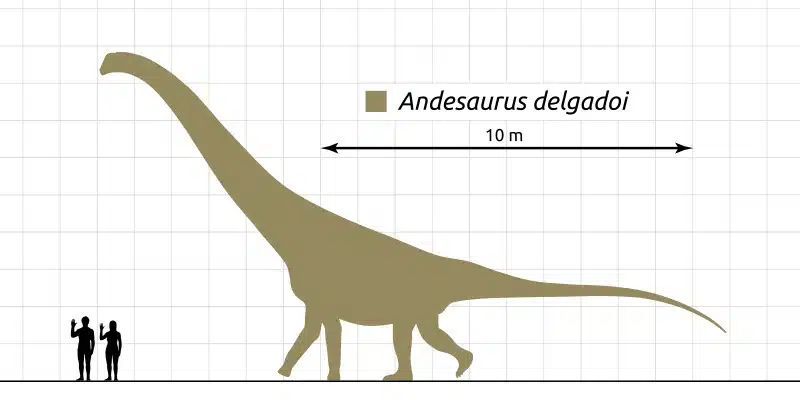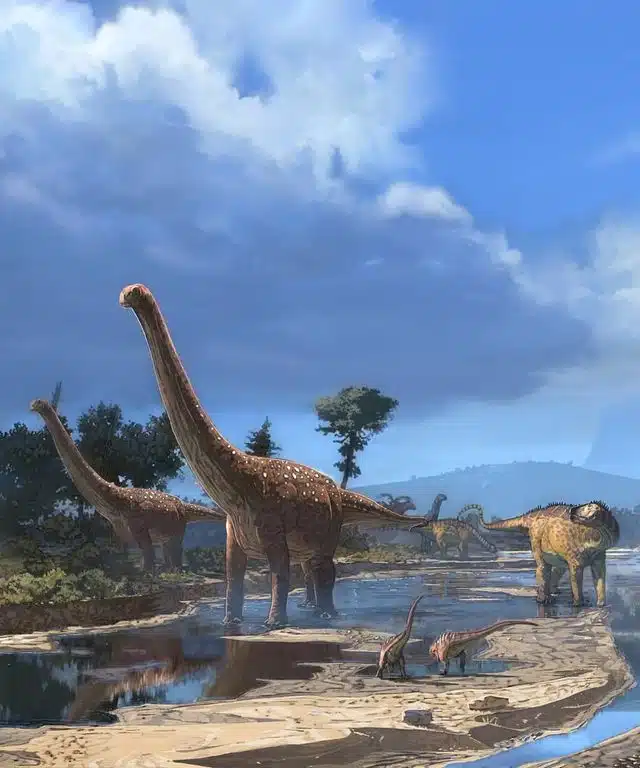Imagine stepping back in time to the Late Cretaceous period, a time when the continents were still shifting into the positions we know today. The air is thick with the scent of ancient vegetation and the earth trembles beneath the weight of colossal creatures. Among these giants, one stands out– Andesaurus. This titan of a dinosaur, whose name fittingly means “Andes Lizard,” roamed the earth during a time when the world was an unrecognizable place.
Andesaurus is a testament to the incredible diversity and adaptability of life on Earth. As we delve into its world, we’ll explore its unique characteristics, its place in the grand tapestry of evolution, and the environment it once called home. So, let’s embark on this journey together, stepping into the footprints of this dinosaur and exploring a chapter of our planet’s history that continues to captivate and intrigue.
Andesaurus Key Facts
| Keyword | Fact |
|---|---|
| Andesaurus pronunciation | AHN-dee-SOR-us |
| Meaning of name | Andes Lizard |
| Group | Sauropod |
| Type Species | Andesaurus delgadoi |
| Diet | Herbivore |
| When it Lived | 99.6 to 93.5 MYA |
| Period | Late Cretaceous |
| Epoch | Early/Lower Cenomanian |
| Length | 49.0 to 60.0 ft |
| Height | 29.5 ft |
| Weight | 7.0 tons |
| First Discovery | 1987 by Alejandro Delgado |
| Location of first find | Río Limay Formation El Chocón, Neuquén Province, Argentina |
| First Described by | 1991 by Jorge Orlando Calvo and José Fernando Bonaparte |
| Holotype | MUCPv 132 |
Andesaurus Origins, Taxonomy and Timeline

Andesaurus comes with a name that translates to “Andes Lizard,” as a testament to the region where its remains were first discovered. The name is a nod to the majestic Andes mountains, a fitting tribute to a creature that once roamed these lands during the Late Cretaceous period.
Belonging to the group of dinosaurs known as sauropods, Andesaurus is part of the Titanosauridae family. This group of dinosaurs is known for their colossal size and long necks. This dinosaur is no exception. Its type species is Andesaurus delgadoi. The species name is a tribute to Alejandro Delgado, after whom the species is named.
This giant lived during the Late Cretaceous period, specifically during the Early/Lower Cenomanian epoch. The continents were still shifting into their current positions and the climate was warmer, with no polar ice caps. This was a world dominated by dinosaurs and Andesaurus was one of the giants of its time.
Discovery & Fossil Evidence
It was first discovered in 1987 by Alejandro Delgado in the Río Limay Formation of El Chocón, Neuquén Province, Argentina. The dinosaur was first described by paleontologists Jorge Orlando Calvo and José Fernando Bonaparte.
The fossil evidence is quite extensive. The remains include parts of the dinosaur’s vertebrae, ribs, and limb bones. These fossils have provided invaluable insights into the size, shape, and physical characteristics of this dinosaur. Further discoveries and studies may yet reveal more about this fascinating creature.
The discovery of this dinosaur has added a significant piece to the puzzle of dinosaur evolution. It has helped scientists understand more about the diversity and adaptability of dinosaurs, and how they were able to thrive in a variety of environments. Each new discovery brings us one step closer to understanding these incredible creatures and the world they once inhabited.
Andesaurus Size and Description
This was a true giant of immense size, much like its sauropod relatives. Its long neck stretched out to reach the tops of trees, while its equally long tail provided balance. Its body was robust and barrel-shaped, supported by four sturdy legs.
It was a quadrupedal dinosaur (naturally I’d say), moving on all four limbs. Its body was typical of a sauropod–a small head perched on a long neck, a large body, and a lengthy tail. The limbs were column-like and ended in broad feet. The skin was likely thick and rough like other sauropods, providing some protection from predators and environmental hazards.
The vertebrae were unique, with depressions and cavities that helped reduce the weight of its massive body. This adaptation is common in titanosaurs and allowed these giants to grow to such impressive sizes without being hindered by their own weight.
Size and Weight of Type Species

Ongoing research is still determining the exact size and weight of this dinosaur. Despite the incomplete nature of the fossil record that challenges precise estimates, the available fossils and comparisons with closely related species indicate that this dinosaur likely measured between 49.0 to 60.0 feet in length and stood at a height of 29.5 feet. Its weight is estimated to have been around 7.0 tons. Clearly, this was a large dinosaur.
The Dinosaur in Detail
Despite its unmistakable size, Andesaurus was a creature of subtle complexities. Its unique vertebral structure, for instance, is a marvel of natural engineering. The cavities and depressions in the vertebrae not only reduced the dinosaur’s weight but also increased its flexibility, allowing it to move its massive body with surprising ease.
One of the most notable specimens of Andesaurus is the holotype MUCPv 132. This specimen consists of parts of the vertebral column, ribs, and limb bones, and has provided invaluable insights into the anatomy of this dinosaur. Each bone tells a story of a life lived millions of years ago, offering a glimpse into a world that no longer exists.
Like all dinosaurs, this was a product of its environment. Its size and structure were adaptations to a world vastly different from our own, a testament to the incredible diversity and adaptability of life on Earth.
Andesaurus in its Natural Habitat

Andesaurus lived in what is now modern-day Argentina, a region that was likely a lush, forested environment during the Late Cretaceous period. The climate would have been warm and the landscape dotted with rivers and lakes. This environment would have been rich in vegetation and provided ample food for an herbivore like Andesaurus.
As an herbivorous dinosaur, Andesaurus likely fed on a variety of plant life and used its long neck to reach vegetation that other dinosaurs couldn’t. Its large size would have deterred most predators, although it’s possible that young or sick individuals could have fallen prey to large carnivorous dinosaurs.
Andesaurus, like many sauropods, likely led a slow-paced life and spent much of its time eating to sustain its massive body. It’s unclear whether the Andesaurus lived in herds or led a solitary existence but either way, its presence would have significantly shaped the landscape and ecosystem around it.
Interesting Points about Andesaurus
- This is one of the few dinosaurs named after a mountain range, reflecting the location of its discovery.
- Because it was such a massive creature, it had a unique vertebral structure that helped reduce its weight.
- It belongs to the Titanosauridae family, a group of dinosaurs known for their immense size.
- This dinosaur lived during the Late Cretaceous period, a time of high sea levels and warm climates.
- The holotype of Andesaurus, MUCPv 132, provides valuable insights into the anatomy and lifestyle of this dinosaur.
Contemporary Dinosaurs
In the lush, prehistoric landscapes of South America, the colossal Andesaurus reigned supreme. This titanic dinosaur was a gentle giant that peacefully grazed on the verdant foliage of the Cretaceous period. Its size was awe-inspiring, dwarfing many of its contemporaries. Yet, it shared its world with other giants. One such contemporary was Argentinosaurus–a fellow sauropod that was roughly the same size, if not slightly larger. These two behemoths would have painted a picture of serene coexistence, their massive forms casting long shadows under the ancient sun.
However, life in the Cretaceous was not all tranquility and peaceful grazing. Andesaurus and Argentinosaurus, despite their size, had to contend with the formidable Giganotosaurus. This predator was larger than the infamous T-Rex. This fearsome carnivore was a constant threat, its presence a reminder of the delicate balance of the ecosystem. Andesaurus, despite its size, could have been prey for this relentless hunter. The thought of such a titanic struggle is an example of the harsh realities of life in the prehistoric world.
Yet, not all interactions were fraught with danger. A fellow sauropod, Limaysaurus, was smaller than Andesaurus. They likely coexisted without much competition since their diets possibly differed enough to allow for peaceful cohabitation. The sight of these different-sized sauropods peacefully feeding side by side would have been a testament to the diversity and harmony of this ancient ecosystem.
Through the lens of Andesaurus, we glimpse a vibrant, dynamic world. A world of towering giants and fearsome predators, of peaceful coexistence and brutal survival. Through the Andesaurus and its interactions with its contemporaries, we are able to understand a vivid picture of life in the Cretaceous period.
List of All Dinosaurs
We have created a list of all dinosaurs we have covered here, sorted across the seven main groups of dinosaurs. We also include information about their type of diet, (omnivore, herbivore or carnivore) and the time they lived.
Frequently Asked Questions
The name means ‘Andes Lizard’, a tribute to the Andes mountains where its remains were first discovered.
It was an herbivore, feeding on a variety of plant life. It used its long neck to reach vegetation that grew in the highest levels.
This dinosaur lived during the Late Cretaceous period, specifically the Early/Lower Cenomanian epoch, approximately 99.6 to 93.5 million years ago.
The first remains were discovered in Argentina.
It belongs to the Titanosauridae family, a group of dinosaurs known for their large size and long necks.
Sources
Please note that the information in this article is based on various sources, drawing on scientific research, fossil evidence, and expert analysis. The aim is to provide a comprehensive and accurate overview of the Andesaurus, but please be aware that our understanding of dinosaurs and their world is constantly evolving as new discoveries are made.
- https://naturalhistory.si.edu/sites/default/files/media/translated_publications/Calvo%26amp%3BBonaparte%25201991.pdf
- https://www.arca.museus.ul.pt/ArcaSite/obj/gaia/MNHNL-0000281-MG-DOC-web.PDF
- https://www.researchgate.net/publication/40662783_A_revision_of_Titanosaurus_Lydekker_Dinosauria-Sauropoda_the_first_dinosaur_genus_with_a_Gondwanan_distribution
- https://www.researchgate.net/publication/362978138_A_new_nanoid_titanosaur_Dinosauria_Sauropoda_from_the_Upper_Cretaceous_of_Brazil
This article was last fact-checked: Joey Arboleda, 07-25-2023
Featured Image Credit: Levi bernardo, CC BY-SA 3.0, via Wikimedia Commons
